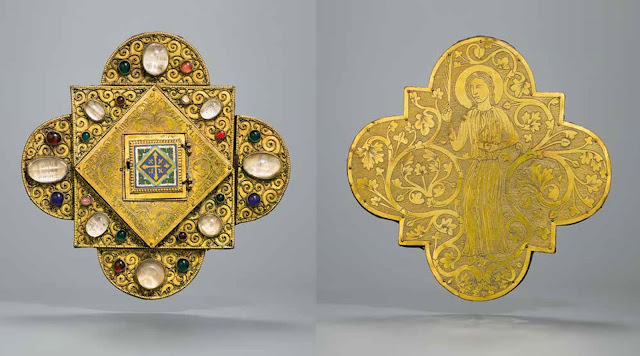 |
| Reverse St Andrew Phylactery |
During the Middle Ages reliquaries held a special place of pride and any religious house was keen on having a collection of relics. It was precisely the arrival and installation of relics as well as consecration of a new altar in the Priory (1228) that became an occasion to commission an ensemble of luxurious liturgical and religious artefacts that included chalice and paten, ciborium, altar cross, candlesticks, a festive Evangeliary as well as a number of special reliquaries. Of these objects, of special interest and focus here are the splendid and rare specimens of phylacteries for the relics of saints venerated in the Priory of D’Oignies. Phylactery is a special type of a large reliquary that was suspended from the ceiling (proximate to the altar), sometimes phylacteries might be carried in processions. It does not seem that they were meant to be worn – the way Jewish phylacteries or Byzantino-Greek amulets or medals might be worn on ones person. Although it is interesting to consider that a sanctuary or a church might ‘wear’ its own phylactery. This seems to have been the case with D’Oignies.
 |
| St. Andrew Phylactery |
 |
| St Hubert Phylactery |
The Treasure of D’Oignies lists five amazing phylacteries that are featured in this article. These were unusual and splendid objects even during the time they were fashioned. Hugo’s creative enterprise can and should be an encouragement to contemporary artists who wish to make an impact in the field of religious and liturgical arts. Prior to Hugo’s project, phylacteries were not designed as he envisioned them – just look at Jewish phylacteries or Greek amulets. Neither were phylacteries this large or as luxuriously decorated. Hugo’s boldness set the tone for what history of liturgical art regards as standard for what an ideal phylactery / reliquary can be. The front includes a theca depository and a splendid decorative program consisting of gems, intaglios, filigree, and enamel. The reverse feature chased representations of the saints whose relics are enshrined in the reliquary. The phylacteries are quite large, each one about 40 cm in diameter.
 |
| St. Martin Phylactery |
 |
| St. Margaret Phylactery |
 |
| Reverse St. Martin Phylactery |
Photography credits: all images in this article are sourced from The Treasure of Oignies. King Baudouin Foundation, 2013.










